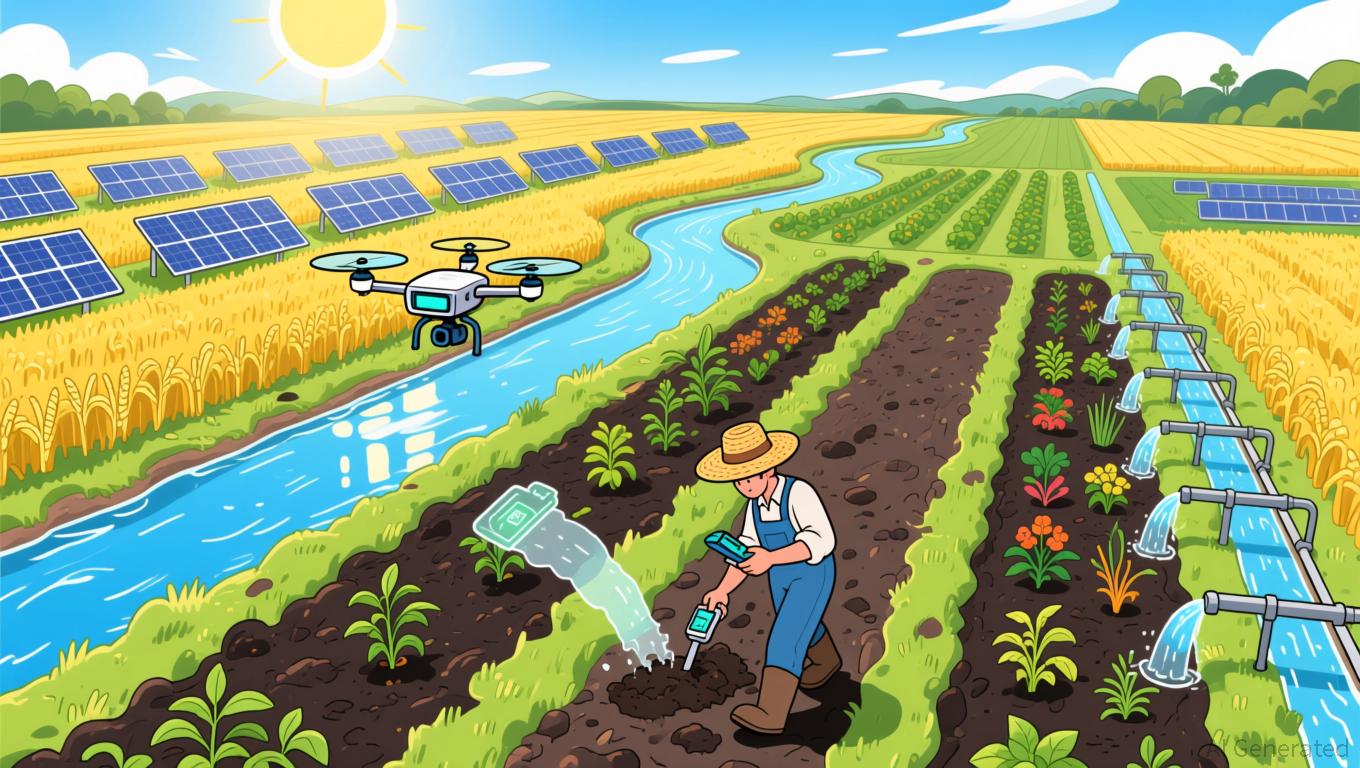Farmers Struggle for Water Amid the Growth of AI Data Centers
- AI infrastructure's rising energy and water demands clash with agriculture's resource needs, straining global grids and water supplies. - U.S. farmers face higher costs as data centers drive up electricity prices and deplete water in drought-prone regions. - Initiatives like Honda's regenerative agriculture program and autonomous farming robots aim to mitigate resource conflicts through sustainability. - Policy responses, including U.S. farm relief plans and COP30 climate negotiations, highlight agricult
The increasing consumption of electricity and water by artificial intelligence (AI) infrastructure is causing concern within the agricultural industry, as resources traditionally dedicated to farming are now being diverted to power-hungry data centers. Although AI is often touted for its future potential to enhance productivity, immediate pressures on power grids and water reserves are already sparking demands for regulatory action and sustainable solutions to ensure that technological progress does not undermine food security.
The environmental impact of AI is drawing significant attention, with data centers—currently responsible for 2% of the world’s electricity use—expanding rapidly to satisfy growing computational needs. In China, the rapid development of AI-focused “smart computing centers” has resulted in an excess of largely idle facilities, many of which draw substantial energy while operating far below capacity. This phenomenon is reflected globally, as data centers contribute to rising electricity costs in places like the U.S. and Europe, putting additional financial strain on energy-reliant sectors such as agriculture. At the same time, the heavy water usage required for cooling these centers further depletes local water resources, a challenge that is particularly severe in drought-affected agricultural regions.
The conflict between AI’s appetite for resources and the requirements of agriculture is especially pronounced in the United States, where farmers are contending with reduced water availability and escalating energy expenses. Honda’s recent partnership with the Carbon by Indigo initiative to promote regenerative farming practices is one example of efforts to ease these challenges. By investing in soil health and water-saving methods across 214,000 acres, the company seeks to strengthen resilience against resource shortages while also cutting carbon emissions.

Market forces are also evolving in response to these issues. The autonomous agriculture robot market,
Governments are beginning to respond with policy measures.
The conversation about AI’s environmental effects extends beyond just energy and water.
As AI’s reach grows, there is a growing recognition among stakeholders of the need for cooperation. “Remember, we still need to produce food,” industry leaders caution, stressing that advances in AI should not jeopardize the stability of agriculture. With both data centers and farms competing for limited resources, future solutions will depend on innovations that maximize efficiency and policies that ensure fair allocation.
Disclaimer: The content of this article solely reflects the author's opinion and does not represent the platform in any capacity. This article is not intended to serve as a reference for making investment decisions.
You may also like
Bitcoin Updates: Bitcoin ETFs See Outflows as Solana Picks Up Speed
- Bitcoin ETFs saw $75.4M net inflow led by BNY Mellon's IBIT , contrasting Ethereum ETFs' $37.4M outflow. - Abu Dhabi's ADIC tripled BlackRock IBIT holdings to $520M amid Bitcoin's 6-month price drop below $100K. - Solana ETFs gained $48.5M in 16-day streak, while BlackRock's IBIT faced record $523M outflow on Nov 19. - Analysts cite "mini bear market" from fading ETF inflows and weak macro signals, but note Solana staking and policy clarity as potential rebounds.

Naver Acquires Dunamu: Stablecoin Integration and Super App Approach to Lead South Korea's Digital Financial Market
- Naver acquires Dunamu via equity swap to enter digital finance, merging with Upbit, South Korea's top crypto exchange. - The deal aims to launch a won-backed stablecoin and create a "super app" combining payments, e-commerce, and crypto trading. - Dunamu's 300% Q3 profit surge and 50.6% market share highlight its strategic value, though antitrust concerns and regulatory challenges persist. - Naver's move aligns with global trends of tech giants consolidating crypto infrastructure, leveraging scale to acc

Algo Price Increases by 0.99% as Parent Company Raise Financial Purchases Stratzy to Strengthen Algorithmic Trading Features
- Raise Financial acquired Stratzy, a 2021-founded algo-trading startup, in a $4–4.5M cash-and-stock deal to boost Dhan’s automated trading capabilities for retail investors. - Stratzy’s 20-person team will join Raise Financial, enhancing Dhan’s competitive edge in India’s growing algorithmic trading market amid rising retail demand for quant strategies. - The acquisition follows a $120M funding round and aligns with India’s regulatory push for retail access to algo-trading, as 97% of foreign investor prof

Bitcoin News Update: PENGU Faces a Price Showdown: Balancing Market Stability and Ecosystem Expansion
- PENGU token, Pudgy Penguins' governance token, trades near $0.012 after 5% weekly decline, with traders eyeing a potential rebound toward $0.023. - Projected 2030 growth to $35–$180 hinges on ecosystem expansion in gaming/metaverse and brand partnerships driving token utility. - Broader crypto market weakness, including Bitcoin's $95k slump and $867M ETF outflows, pressures PENGU amid heightened bearish sentiment. - Key factors for PENGU's trajectory include NFT floor price stability, institutional crypt
